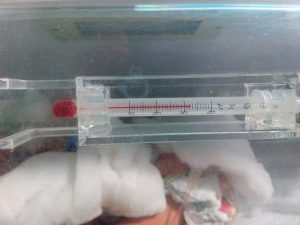Temperature is one of the important parameters of a multiparameter monitor to maintain thermoregulation in adults, newborns,s and infants. Three temperature monitoring facilities in the monitor using probes. It is a useful diagnostic tool and especially true when differential temperatures need to be monitored. Normal temperature for baby, the adult with ranges
Critical Temperature
Temperature below which a gas can be stored in liquid form.
The ideal temperature for the Adult patient in Operating Room- 21°C
For Pediatric patient in Operating Room – 26°C
Core Temperature of the body 37°C
Core Temperature of the body is defined as the temperature measured inside the internal organ of the body.
Normal Temperature for baby
It ranges from 97.9°F to 100.4°F in infants and newborn
The body temperature of premature baby and temperature of the incubator. The phototherapy using an Incubator helps in maintaining the temperature of the newborn after the delivery. The Temperature measurement is as follows

Core temperature (Oral and Oesophageal) and the temperature of the periphery (Skin).
The temperature difference between oral and rectal readings (for e.g., in suspected appendicitis)
Although the temperature is an extremely easy parameter to monitor, for a realistic interpretation of data, most important to bear in mind the influence of such factors as:
Part of the body, where the monitoring temperature. (Extremities are always at a lower temperature than core temperature.)
Body temperature changes throughout the day.
The normal temperature in Adult
Ranges from 97.7°F to 99.5 °F
Menstrual cycle. A rise of about 03°C takes place during ovulation.
The three zones most commonly used for measuring temperature are:
Rectal (typically 37°C)
Oral (typically 37°C)
Axillary (underarm/armpit) (typically 36°C)
some times the ear can also use to measure the temperature
Preference for rectal measurement since it shows the most accurate. measurement subject to patient movement, axillary the least favored.
check for the appropriate temperature probe for the monitor
Rectal I Oesophageal temperature probe (Adult).
Rectal I Oesophageal temperature probe (Neonatal).
Tape-on skin probe.
Nasal Temperature Probe
Clinical Thermometer used to measure the Temperature of the patients apart from the probes
The site used to measure the temperature
Armpit/axillary
Mouth
Ear
Rectum
Hypothermia patient
When the body core temperature falls lesser than the minimum value, the patient needs action to maintain the normal temperature
High risk in Pediatric and newborns in hypothermia
Cover the head in newborn and infant to avoid hypothermia
Cover the body with warm clothes and change wet clothes to avoid hypothermia
Continuous monitoring of the patients with appropriate probes connected to monitor
Administer warm IV fluids using regulated fluid warmer with continuous monitoring
Use a warmer machine either Fluid based warmer with a blanket or pneumatic warming device should be used to warm the patients.
Fever in patients
If the Normal temperature of the body exceeds the level the fever starts. They remove the blankets and give wet padding to the body surfaces. The
Remove the warming device connected to the patient’s side.
Administer the drugs to regulate the body temperature prescribed by the physician